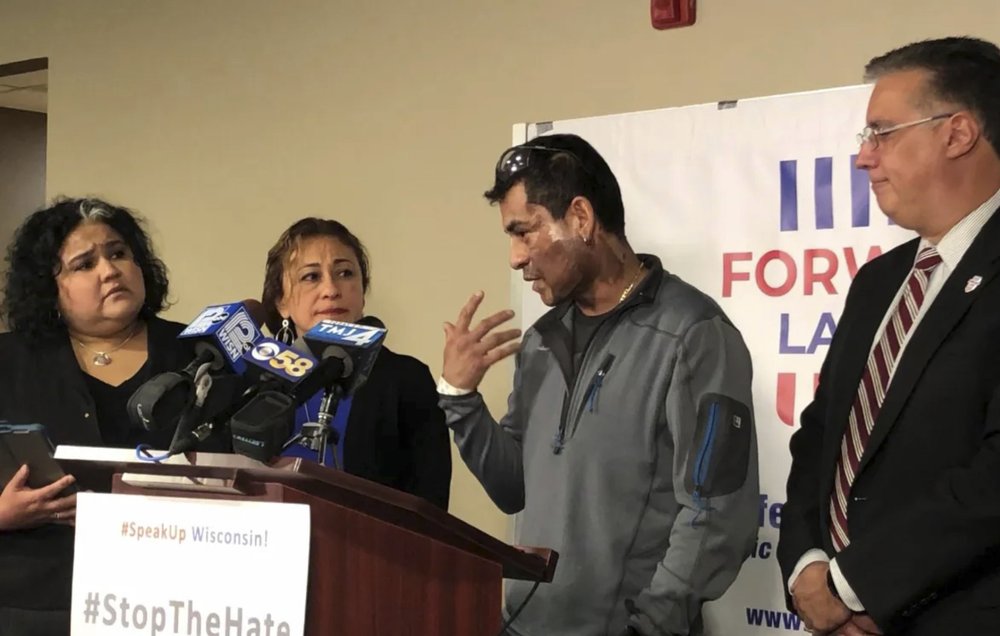Wisconsin
Hispanic man says Milwaukee acid attacker accused him of invading U.S.

MILWAUKEE (AP) — Milwaukee police arrested a man suspected of throwing battery acid on a Hispanic man who says his attacker asked him, “Why did you come here and invade my country?”
Police said Monday they arrested a 61-year-old white man suspected in Friday night’s attack, but they have not released his name. Police said they are investigating the case as a hate crime and charges are expected Tuesday.
Mahud Villalaz suffered second-degree burns to his face. He said the attack happened after a man confronted him about how he had parked his car and accused him of being in the U.S. illegally. Villalaz, 42, is a U.S. citizen who immigrated from Peru.
The attack comes amid a spike in hate crimes directed at immigrants that researchers and experts on extremism say is tied to mainstream political rhetoric.
At a news conference Monday, Milwaukee Mayor Tom Barrett expressed shock at the attack and blamed President Donald Trump for inciting hatred against minorities. The president has repeatedly referred to migrants attempting to cross the U.S.-Mexico border as an “invasion.”
“To single out someone because they’re from a Hispanic origin is simply wrong. And we know what’s happening,” Barrett, a Democrat, said. “Everybody knows what’s happening. It’s because the president is talking about it on a daily basis that people feel they have license to go after Hispanic people. And it’s wrong.”
The White House did not immediately comment.
A report issued last year by the Anti-Defamation League said extreme anti-immigrant views have become part of the political mainstream in recent years through sharp rhetoric by anti-immigration groups and politicians, including Trump.
Surveillance video shows the confrontation but does not include audio.
Villalaz told reporters on Saturday that he was headed into a Mexican restaurant for dinner when a man approached him and told him, “You cannot park here. You are doing something illegal.” He said the man also accused him of being in the U.S. illegally and of invading the country.
He said he ignored the man and moved his truck to another block. But when he returned to the restaurant, the man was waiting for him with an open bottle, Villalaz said.
The man again accused him of being in the U.S. illegally, Villalaz said. He then told the man that he was a citizen and that “everybody came from somewhere else here,” Villalaz said.
That’s when he says the man tossed acid at him. Villalaz turned his head, and the liquid covered the left side of his face.
Villalaz’s sister told The Associated Press on Monday that her brother believes the man was prepared and wanted to attack someone.
“He’s in shock. He says he can’t conceive how someone would be intent on harming someone like that,” Villalaz said in Spanish.
She said her brother is recovering. She said the doctor who treated him said it helped that he immediately washed his face several times inside a restaurant. His family created a GoFundMe page to cover his medical expenses.
Data collected by the FBI showed a 17% increase in hate crimes across the U.S. in 2017, the third annual increase in a row. Anti-Hispanic incidents increased 24%, from 344 in 2016 to 427 in 2017, according to the FBI data. Of crimes motivated by hatred over race, ethnicity or ancestry, nearly half involved African Americans, while about 11% were classified as anti-Hispanic bias.
Brian Levin, director of the Center for the Study of Hate and Extremism at California State University-San Bernardino, released a study in July that found a 9% increase in hate crimes reported to police in major U.S. cities in 2018. Levin found a modest decrease in bias crimes against Hispanic or Latino people — from 103 in 2017 to 100 in 2018 — in 10 major cities, including New York, Chicago and Los Angeles. However, Levin has said the totals likely would have increased last year if not for an unexplained drop in anti-Hispanic bias crimes reported for Phoenix, from 25 in 2017 to 10 in 2018.







